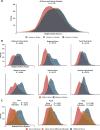Longitudinal analysis of microbial interaction between humans and the indoor environment
- PMID: 25170151
- PMCID: PMC4337996
- DOI: 10.1126/science.1254529
Longitudinal analysis of microbial interaction between humans and the indoor environment
Abstract
The bacteria that colonize humans and our built environments have the potential to influence our health. Microbial communities associated with seven families and their homes over 6 weeks were assessed, including three families that moved their home. Microbial communities differed substantially among homes, and the home microbiome was largely sourced from humans. The microbiota in each home were identifiable by family. Network analysis identified humans as the primary bacterial vector, and a Bayesian method significantly matched individuals to their dwellings. Draft genomes of potential human pathogens observed on a kitchen counter could be matched to the hands of occupants. After a house move, the microbial community in the new house rapidly converged on the microbial community of the occupants' former house, suggesting rapid colonization by the family's microbiota.
Copyright © 2014, American Association for the Advancement of Science.
Figures



References
-
- Höppe P, Martinac I. Indoor climate and air quality. Review of current and future topics in the field of ISB study group 10. Int J Biometeorol. 1998;42:1–7. - PubMed
-
- Custovic A, Taggart SCO, Woodcock A. House duet mite and cat allergen in different indoor environments. Clin Exp Allergy. 1994;24:1164–1168. - PubMed
-
- Dekio I, et al. Detection of potentially novel bacterial components of the human skin microbiota using culture-independent molecular profiling. J Med Microbiol. 2005;54:1231–8. - PubMed
Publication types
MeSH terms
Grants and funding
LinkOut - more resources
Full Text Sources
Other Literature Sources
Medical
Molecular Biology Databases

